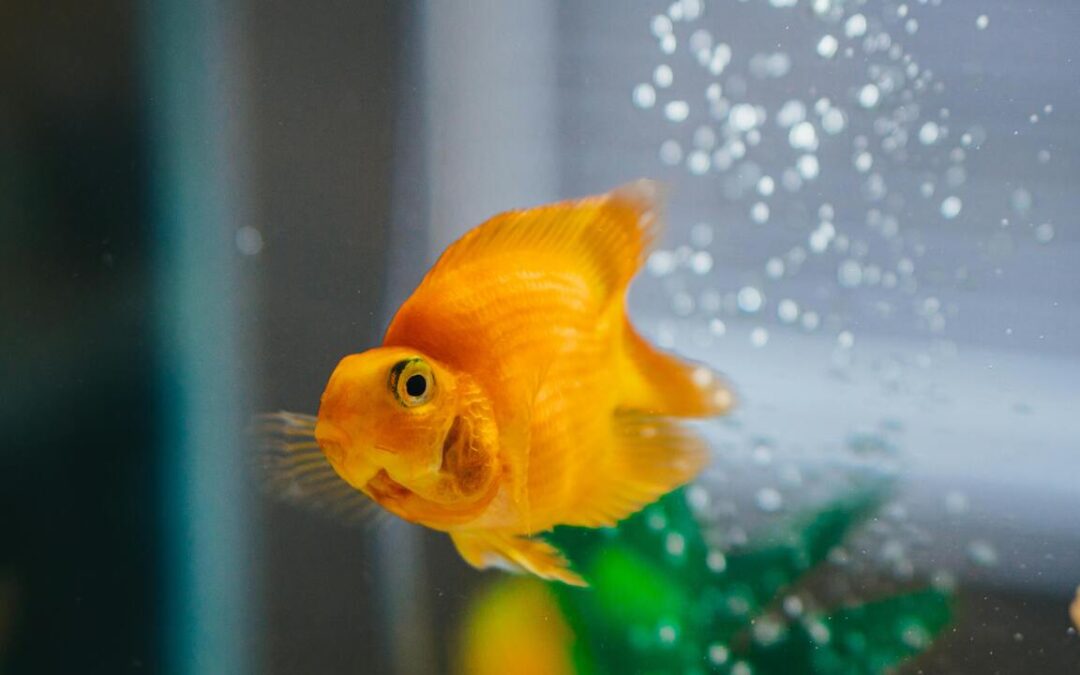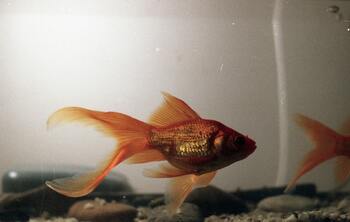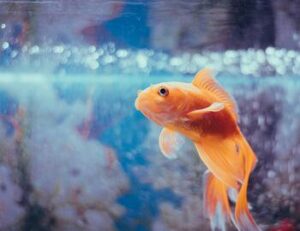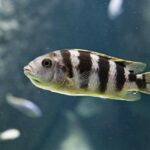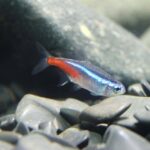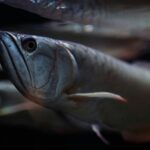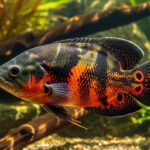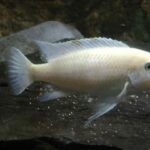Goldfish are one of the most beloved aquarium pets in the world—and for good reason. They’re colorful, charming, full of personality, and relatively easy to care for. But one of the most misunderstood parts of goldfish care is their diet. What do goldfish really eat? Is fish food enough? Can they eat veggies? What about fruit?
If you’ve ever stared into your goldfish’s eager eyes, wondering what to feed next—or felt confused by all the options out there—you’re not alone. The truth is, goldfish are omnivores, which means they eat both plants and animals. But just because they can eat a wide variety of foods doesn’t mean every food is good for them.
In this guide, we’ll dive into the nitty-gritty of what goldfish actually eat, what they love, what to avoid, and how to feed them in a way that keeps them healthy, energetic, and vibrant. Whether you’re new to fishkeeping or looking to fine-tune your feeding habits, this is everything you need to know.
Goldfish Are Omnivores—What That Means for Their Diet
Goldfish are naturally curious grazers. In the wild, they spend their time poking around in plants, mud, and shallow water, searching for small insects, algae, plant matter, crustaceans, and even detritus (organic waste). Their digestive systems are adapted to process a mix of animal proteins and plant-based materials.
So, in captivity, the goal is to replicate that varied diet as much as possible—with a balance of commercial fish food, veggies, proteins, and the occasional treat. A boring, one-note diet can lead to poor health, dull colors, and digestive issues.
The Building Blocks of a Balanced Goldfish Diet
Let’s break down the goldfish menu into the core food groups. Think of it like a weekly meal plan—fish style.
1. Commercial Goldfish Food: Flakes vs. Pellets
Commercial goldfish food is usually the foundation of a goldfish’s diet. It’s formulated to provide essential nutrients, but there’s still a quality difference you should watch out for.
Flakes
- Best for small or juvenile goldfish
- Float on top—great for top feeders
- Can lose nutritional value quickly if left out
- May cloud water if uneaten
Pellets
- Available in sinking or floating varieties
- Often better for larger goldfish
- Soak before feeding to prevent bloating
Pro tip: Look for fish food that includes real fish meal, spirulina, and color-enhancing ingredients like astaxanthin with added vitamins like vitamin C and D, and a label that says “specifically made for goldfish.” Rotate different brands every few weeks to provide better nutritional coverage.
2. Protein Foods: The Goldfish Super Snacks
Goldfish may not look like predators, but they love a bit of meaty goodness now and then. Protein-rich foods are great for energy, growth, and overall excitement at feeding time.
Best protein snacks include:
- Brine shrimp (live or frozen) – A small, meaty favorite
- Bloodworms (best offered in moderation) – High in fat
- Daphnia (especially good for digestion)
- Mosquito larvae (safe, frozen or live) Available in some specialty fish stores
- Tubifex worms – Nutrient-dense, but rinse well or use freeze-dried
Feeding frequency: 2–3 times a week is enough. Too much protein can be hard on their digestive system.
Tip: Avoid feeding raw or fatty meats like beef heart or pork. Goldfish can’t digest mammalian fat properly.
3. Vegetables: Goldfish Love Their Greens
Veggies are not just filler—they’re vital for digestion, color, and overall health. Goldfish love vegetables!
Here’s a list of fish-safe veggies and how to prepare them:
| Vegetable | How to Prepare | Benefits |
| Peas | Boil, remove shell, mash | Prevents constipation |
| Spinach | Blanch to soften | Iron-rich, boosts immunity |
| Lettuce | Tear into small pieces | Adds fiber, easy to digest |
| Zucchini | Slice and lightly boil | Low-cal, hydrating |
| Carrots | Boil and mash | Good for color and eyesight |
| Broccoli | Steam small florets | Rich in vitamins and antioxidants |
Prep Tip: Always boil or blanch hard veggies. Let cool before serving. Use a veggie clip or skewer for easier feeding.
Never feed raw beans, onions, or garlic—they are toxic to fish.
4. Occasional Treats: Fruits, Eggs, and Homemade Foods
While fruits shouldn’t be a regular part of the diet, they can be fun and nutritious in small amounts.
Goldfish-safe fruits include:
- Banana (mashed)
- Berries like strawberries, blueberries (sliced)
- Apples (peeled)
- Watermelon (seedless)
- Orange slices (no rind or seeds, minimal)
Other special treats:
- Boiled egg yolk – Mash it finely; rich in protein but messy.
- Algae wafers – Especially if your tank has algae-loving species.
- Gel food – Homemade blends of fish food, veggies, gelatin, and supplements.
Limit fruits to once a week, and always remove leftovers quickly to prevent clouding the water.
Foods to Avoid at All Costs
Not everything that seems edible is actually good for your goldfish. Some foods can upset their digestion, cause bloating, or introduce toxins.
Avoid feeding your goldfish:
- Bread or pasta – Swells in their stomach, causes blockage
- Sugary or salted human foods
- Crackers or chips – Too salty and processed
- Citrus fruits in large amounts – Too acidic
- Onions, garlic – Toxic to fish
- Spicy, greasy, or fried foods
- Processed meats or dairy
- Mammal fat/raw meats or fatty meal (beef heart, bacon) – Difficult to digest
Even if your fish seems interested in people food, it doesn’t mean it’s safe. Stick to clean, fish-safe options.
Feeding Frequency: How Much and How Often to Feed a Goldfish?
One of the most common mistakes among new fishkeepers is overfeeding. Goldfish are natural beggars—they’ll swim to the front of the tank and act like they haven’t eaten in days. Don’t fall for it!
Basic rule:
Feed adult goldfish once or twice a day, giving only what they can finish in 2 minutes.
For baby goldfish or fry:
Feed 3–4 small meals per day, as they grow rapidly and need more energy.
A good feeding routine:
- Morning: Flakes or pellets
- Evening: Veggies or protein treat
- Sunday: Fast day (skip feeding to let their system reset)
Goldfish don’t have stomachs, so small, frequent meals are better than one large dump of food.
Sample Weekly Feeding Schedule (Adult Goldfish)
| Day | Morning Meal | Evening Meal |
| Monday | Goldfish flakes | Blanched spinach |
| Tuesday | Sinking pellets | Daphnia (frozen) |
| Wednesday | Peas (shelled) | Pellets |
| Thursday | Brine shrimp (frozen) | Zucchini slice |
| Friday | Flakes | Bloodworms (small amt) |
| Saturday | Lettuce or kale | Gel food or veggie mix |
| Sunday | Fasting day | Fasting day |
This kind of variety keeps your fish excited, well-nourished, and active all week long.
Why Variety Is the Secret to Healthy Goldfish
Imagine if you ate nothing but dry cereal every day. You might survive, but you wouldn’t thrive—and the same goes for your goldfish.
Here’s why a varied diet matters:
- Different nutrients from different foods
- Better digestion with fiber-rich veggies
- Brighter colors and improved fin health
- Reduced boredom and increased activity
Switch things up often. Try a new veggie. Alternate between flakes and pellets. Surprise them with daphnia now and then. Feeding time is enrichment time!
How Diet Affects Goldfish Color and Longevity
A goldfish’s colors aren’t just about genetics—they’re also tied to what they eat.
Foods that enhance color include:
- Shrimp (rich in astaxanthin)
- Spirulina algae
- Carrots and red peppers (beta-carotene)
A poor diet can cause dull coloring, white patches, or early fading. A nutrient-rich diet helps keep reds bold, oranges vibrant, and whites clear.
Healthy fish = happy, long-lived fish. A properly fed goldfish can live:
- In bowls/tanks: 5–10 years (if cared for well)
- In ponds: 15–20+ years!
Enrichment During Feeding
Feeding time isn’t just about nutrition—it’s a great time to mentally stimulate your goldfish.
Try:
- Hand feeding (after they get used to you)
- Floating veggie clips
- Sinking gel food molds (different shapes)
- Scattering pellets across the surface for natural foraging behavior
These keep your goldfish engaged, curious, and more active.
Frequently Asked Questions (FAQs)
1. Can goldfish eat rice or bread?
No. These starchy foods swell in their digestive tract and can cause bloating or constipation. Stick to natural, water-rich veggies instead.
2. Why is my goldfish spitting out its food?
It could be too big, too hard, or unappealing. Try softening pellets or switching to a different brand. Some goldfish are picky!
3. Can goldfish eat tropical fish food?
Occasionally, yes—but it’s not ideal. Tropical fish food is formulated for different dietary needs. Stick to food made specifically for goldfish.
4. What’s the best vegetable for goldfish?
Peas are a fan favorite. They’re easy to digest and help prevent constipation. Just remember to remove the shell and boil them first.
5. How can I tell if I’m feeding too much?
If uneaten food collects at the bottom, or your fish has a bloated belly or stringy white poop, you’re likely overfeeding.
6. Can I grow food for my goldfish at home?
Yes! Many aquarists grow duckweed or lettuce in small aquatic gardens. It’s a great way to provide fresh greens and enrich their environment.
7. Should I feed goldfish during water changes?
It’s best to feed after the water change, not before. This keeps the tank cleaner and prevents uneaten food from getting stirred up.
8. What should I feed a sick or bloated goldfish?
Peas are the go-to remedy. Boil, remove the shell, and mash. Also reduce or skip pellets for a few days and feed only vegetables.
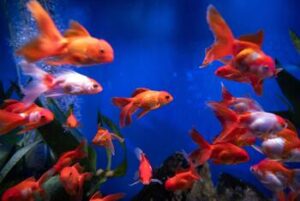
9. Can I feed my goldfish every time they beg?
Nope! Goldfish beg constantly, but overfeeding causes water pollution, bloating, and even death. Stick to a set schedule.
10. Is it okay to skip a feeding?
Yes! In fact, one fasting day per week is beneficial for digestion and water quality.
10. Do goldfish need live food?
Not at all. Frozen or freeze-dried versions are just as nutritious and far safer for home aquariums.
Final Thoughts: Feeding Is Care, Not Just a Chore
Feeding goldfish isn’t just about keeping them alive—it’s about keeping them well. The joy of watching a goldfish eat isn’t just the wiggle of excitement when they see you, it’s knowing you’re giving them the care they need to thrive.
By offering a balanced, varied diet with quality food, vegetables, and the occasional protein or fruit treat, you’re helping your goldfish:
- Live longer
- Look brighter
- Swim more actively
- Stay healthier, inside and out
So the next time your goldfish swims up for breakfast, take a moment. You’re not just feeding a fish—you’re building a bond.

